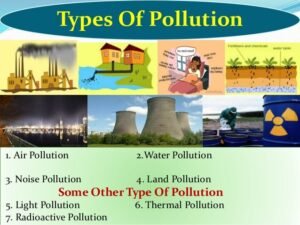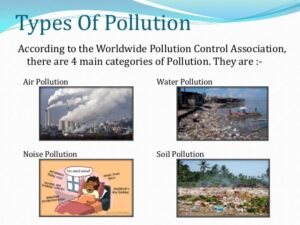Back to: Physical and Health Education JSS 2
Welcome to class!
In today’s class, we shall be talking about the types of environmental pollution. Please enjoy the class!
Types of Environmental Pollution

Pollution, the unwelcome guest in our beautiful ecosystem, comes in many forms, each with its own insidious way of harming our planet and ourselves. Understanding these different types is crucial for any college student, future citizen, and steward of our shared home. So, grab your metaphorical hazmat suit and prepare to delve into the fascinating, yet concerning, world of environmental pollution!
The Big Three: Air, Water, and Land
Let’s start with the classic trio, the pollution types that immediately pop into mind:

Air Pollution: This invisible menace lurks in the very air we breathe. From the belching smokestacks of factories to the exhaust fumes of our cars, air pollution is a cocktail of harmful gases, particles, and chemicals. It can trigger respiratory problems, heart disease, and even cancer. Think smog-choked cities and hazy skies, a grim reminder of the air’s silent suffering.
Water Pollution: Our lifeblood, water, is far from immune. Industrial waste, agricultural runoff, and even our everyday activities like using harsh chemicals can contaminate water sources. This can lead to unsafe drinking water, disrupted aquatic ecosystems, and the proliferation of harmful algal blooms. Imagine a once-pristine river choked with plastic waste and devoid of fish, a stark illustration of water pollution’s impact.
Land Pollution: The ground beneath our feet is not spared either. Industrial waste dumped on landfills, improper disposal of hazardous materials, and deforestation all contribute to land pollution. This can render soil infertile, contaminate food chains, and disrupt natural habitats. Think of barren landscapes and overflowing landfills, a testament to the scars we leave on the Earth’s surface.
While the air, water, and land take center stage, other types of pollution are increasingly raising concerns:
Noise Pollution: The constant din of traffic, construction, and machinery can be more than just annoying. It can lead to hearing loss, sleep disturbance, and even mental health problems. Imagine the constant drone of city life, a cacophony that never sleeps.
Light Pollution: The artificial glow of city lights disrupts natural night cycles, impacting wildlife and even human health. It can interfere with sleep patterns, hormone production, and even migration patterns in birds. Imagine a night sky devoid of stars, replaced by a luminous urban sprawl.
Thermal Pollution: The release of hot water from power plants and industries can raise water temperatures, harming aquatic life and disrupting ecosystems. Imagine a once-thriving coral reef bleached and lifeless due to rising water temperatures.
Understanding the different types of environmental pollution is just the first step. The real challenge lies in taking action. As college students, you have the power to be agents of change. Here are some ways you can contribute:
- Reduce your own footprint: Walk, cycle, or use public transportation whenever possible. Conserve water and energy. Choose eco-friendly products and say no to single-use plastics.
- Raise awareness: Educate your peers and community about the dangers of pollution. Organize clean-up drives or participate in environmental campaigns.
- Support sustainable practices: Advocate for policies that promote clean energy, sustainable development, and responsible waste management.
Remember, a healthy planet is not a privilege, it’s a responsibility. By understanding the different types of environmental pollution and taking action, we can build a future where clean air, water, and land are not just dreams, but a reality for generations to come.
We have come to the end of today’s class. I hope you enjoyed the class!
In the next class, we shall be discussing the Effects of environmental pollution.
In case you require further assistance or have any questions, feel free to ask in the comment section below, and trust us to respond as soon as possible. Cheers!
Question Time:
Part A: Multiple Choice (1 mark each)
- Which of the following is NOT a major type of environmental pollution?
(a) Air pollution
(b) Light pollution
(c) Noise pollution
(d) Soil erosion
- The main source of acid rain is the emission of:
(a) Carbon dioxide
(b) Sulfur dioxide
(c) Nitrogen oxides
(d) Chlorofluorocarbons
- The practice of dumping untreated industrial waste into rivers can lead to:
(a) Deforestation
(b) Eutrophication
(c) Landfills
(d) Smog
- Which of the following is a harmful consequence of thermal pollution?
(a) Increased air temperature
(b) Disruption of aquatic ecosystems
(c) Depletion of the ozone layer
(d) Acidification of soil
- The use of single-use plastics contributes to:
(a) Noise pollution
(b) Light pollution
(c) Water pollution
(d) Land pollution
Part B: Theory (4 marks each)
- Briefly explain the difference between primary and secondary air pollutants. Give an example of each.
- Describe the major health hazards associated with water pollution. What measures can be taken to reduce water pollution?
- Discuss the impact of deforestation on land pollution and soil fertility. Suggest ways to promote sustainable forest management.
- Explain how noise pollution can negatively affect human health and the environment. What strategies can be implemented to control noise levels in urban areas?
- Compare and contrast the long-term environmental consequences of air pollution and climate change. How can we mitigate the effects of both?
